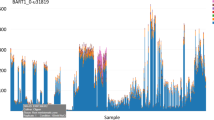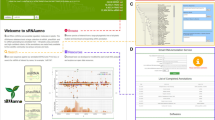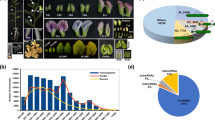Abstract
Identification of all expressed transcripts in a sequenced genome is essential both for genome analysis and for realization of the goals of systems biology. We used the transcriptional profiling technology called 'massively parallel signature sequencing' to develop a comprehensive expression atlas of rice (Oryza sativa cv Nipponbare). We sequenced 46,971,553 mRNA transcripts from 22 libraries, and 2,953,855 small RNAs from 3 libraries. The data demonstrate widespread transcription throughout the genome, including sense expression of at least 25,500 annotated genes and antisense expression of nearly 9,000 annotated genes. An additional set of ∼15,000 mRNA signatures mapped to unannotated genomic regions. The majority of the small RNA data represented lower abundance short interfering RNAs that match repetitive sequences, intergenic regions and genes. Among these, numerous clusters of highly regulated small RNAs were readily observed. We developed a genome browser (http://mpss.udel.edu/rice) for public access to the transcriptional profiling data for this important crop.
This is a preview of subscription content, access via your institution
Access options
Subscribe to this journal
Receive 12 print issues and online access
$209.00 per year
only $17.42 per issue
Buy this article
- Purchase on Springer Link
- Instant access to full article PDF
Prices may be subject to local taxes which are calculated during checkout


Similar content being viewed by others
Change history
23 March 2007
In the version of this article initially published, the fourth author’s name was misspelled. The correct spelling is André Beló. The error has been corrected for all versions of the article.
References
International Rice Genome Sequencing Project. The map-based sequence of the rice genome Nature 436, 793–800 (2005).
Yuan, Q. et al. The Institute for Genomic Research Osa1 rice genome annotation database. Plant Physiol. 138, 18–26 (2005).
Kikuchi, S. et al. Collection, mapping, and annotation of over 28,000 cDNA clones from japonica rice. Science 301, 376–379 (2003).
Bartel, D.P. MicroRNAs: genomics, biogenesis, mechanism, and function. Cell 116, 281–297 (2004).
Verdel, A. et al. RNAi-mediated targeting of heterochromatin by the RITS complex. Science 303, 672–676 (2004).
Meyers, B.C. et al. Analysis of the transcriptional complexity of Arabidopsis thaliana by massively parallel signature sequencing. Nat. Biotechnol. 22, 1006–1011 (2004).
Lu, C. et al. Elucidation of the small RNA component of the transcriptome. Science 309, 1567–1569 (2005).
Cheng, Z. et al. Functional rice centromeres are marked by a satellite repeat and a centromere-specific retrotransposon. Plant Cell 14, 1691–1704 (2002).
Yan, H. et al. Genomic and genetic characterization of rice cen3 reveals extensive transcription and evolutionary implications of complex centromere. Plant Cell 18, 3227–3238 (2006).
Yan, H. et al. Transcription and histone modifications in the recombination-free region spanning a rice centromere. Plant Cell 17, 3227–3238 (2005).
Jen, C.H., Michalopoulos, I., Westhead, D. & Meyer, P. Natural antisense transcripts with coding capacity in Arabidopsis may have a regulatory role that is not linked to double-stranded RNA degradation. Genome Biol. 6, R51 (2005).
Borsani, O., Zhu, J., Verslues, P.E., Sunkar, R. & Zhu, J.K. Endogenous siRNAs derived from a pair of natural cis-antisense transcripts regulate salt tolerance in Arabidopsis. Cell 123, 1279–1291 (2005).
Griffiths-Jones, S. The microRNA Registry. Nucleic Acids Res. 32, D109–D111 (2004).
Lippman, Z. et al. Role of transposable elements in heterochromatin and epigenetic control. Nature 430, 471–476 (2004).
Zhang, X. et al. Genome-wide high-resolution mapping and functional analysis of DNA methylation in Arabidopsis. Cell 126, 1189–1201 (2006).
Yoo, B.-C. et al. A systemic small RNA signaling system in plants. Plant Cell 16, 1979–2000 (2004).
Jiang, N., Bao, Z., Zhang, X., Eddy, S.R. & Wessler, S.R. Pack-MULE transposable elements mediate gene evolution in plants. Nature 431, 569–573 (2004).
Juretic, N., Hoen, D.R., Huynh, M.L., Harrison, P.M. & Bureau, T.E. The evolutionary fate of MULE-mediated duplications of host gene fragments in rice. Genome Res. 15, 1292–1297 (2005).
Morgante, M. et al. Gene duplication and exon shuffling by helitron-like transposons generate intraspecies diversity in maize. Nat. Genet. 37, 997–1002 (2005).
Britten, R. Transposable elements have contributed to thousands of human proteins. Proc. Natl. Acad. Sci. USA 103, 1798–1803 (2006).
Lipatov, M., Lenkov, K., Petrov, D. & Bergman, C. Paucity of chimeric gene-transposable element transcripts in the Drosophila melanogaster genome. BMC Biol. 3, 24 (2005).
Cheng, J. et al. Transcriptional maps of 10 human chromosomes at 5-nucleotide resolution. Science 308, 1149–1154 (2005).
Acknowledgements
We are grateful to C. Haudenschild, TIGR's rice annotation project, S. Singh Tej, M. Nakano, R. German, A. Hetawal, R. Gupta and S. Kaushik. This work was supported by US National Science Foundation awards 0321437 (B.C.M. and G.-l.W.) and 0439186 (P.J.G. and B.C.M.), and US Department of Agriculture 2005-35064-15326 (B.C.M. and P.J.G.).
Author information
Authors and Affiliations
Contributions
K.N. performed research, analyzed data and wrote the manuscript, R.C.V. and C.L. performed laboratory research and provided useful discussions, A.B., K.V., K.K., W.W. and M.P. performed computational research; P.J.G. and G.-l.W. designed research and wrote manuscript; B.C.M. designed research, analyzed data, and coordinated and wrote the manuscript.
Corresponding author
Ethics declarations
Competing interests
The authors declare no competing financial interests.
Supplementary information
Supplementary Fig. 1
Filter results for 22 mRNA MPSS libraries (PDF 21 kb)
Supplementary Fig. 2
Similarity of the pattern among the diverse tissues (PDF 17 kb)
Supplementary Fig. 3
Representation of library-specific genes in each tissue (PDF 123 kb)
Supplementary Fig. 4
Actively expressed genes and intergenic transcripts (PDF 440 kb)
Supplementary Fig. 5
Correlation of sense and antisense expression (PDF 643 kb)
Supplementary Fig. 6
Rice small RNAs are dispersed throughout the genome (PDF 2410 kb)
Supplementary Fig. 7
Small RNA sequences in the completely sequenced centromere of rice (PDF 35 kb)
Supplementary Fig. 8
Classes of genomic features matched by rice small RNAs (PDF 37 kb)
Supplementary Fig. 9
Distribution of small RNAs across rice chromosomes (PDF 358 kb)
Supplementary Fig. 10
Small RNA sequences in a genic region of the rice genome (PDF 3074 kb)
Supplementary Fig. 11
Patterns of retrotransposon silencing and expression in the rice genome (PDF 37 kb)
Supplementary Fig. 12
Tandem and inverted repeats are substantial sources of small RNAs in rice (PDF 39 kb)
Supplementary Fig. 13
Expression and conservation of rice small RNAs (PDF 94 kb)
Supplementary Fig. 14
Number of genes that are supported by MPSS signatures, based on signatures matching multiple locations in the genome (PDF 31 kb)
Supplementary Fig. 15
Co-expression analysis of adjacent genes (PDF 53 kb)
Supplementary Table 1
Libraries and signature counts – summary statistics (PDF 54 kb)
Supplementary Table 2
Genomic signatures and number of corresponding genes (PDF 71 kb)
Supplementary Table 3
Known microRNAs genes and ncRNAs associated with mRNA signatures (PDF 58 kb)
Supplementary Table 4
Summary statistics for small RNA libraries (PDF 53 kb)
Supplementary Table 5
Genomics localization of small RNA signatures (PDF 54 kb)
Supplementary Table 6
Clusters of small RNAs in the rice genome (PDF 51 kb)
Supplementary Table 7
Differential or constant cluster or genes in the rice small RNA libraries (PDF 97 kb)
Rights and permissions
About this article
Cite this article
Nobuta, K., Venu, R., Lu, C. et al. An expression atlas of rice mRNAs and small RNAs. Nat Biotechnol 25, 473–477 (2007). https://doi.org/10.1038/nbt1291
Received:
Accepted:
Published:
Issue Date:
DOI: https://doi.org/10.1038/nbt1291
This article is cited by
-
Omics: a tool for resilient rice genetic improvement strategies
Molecular Biology Reports (2022)
-
Genomics and breeding innovations for enhancing genetic gain for climate resilience and nutrition traits
Theoretical and Applied Genetics (2021)
-
An update to database TraVA: organ-specific cold stress response in Arabidopsis thaliana
BMC Plant Biology (2019)
-
Modulation of defence and iron homeostasis genes in rice roots by the diazotrophic endophyte Herbaspirillum seropedicae
Scientific Reports (2019)



